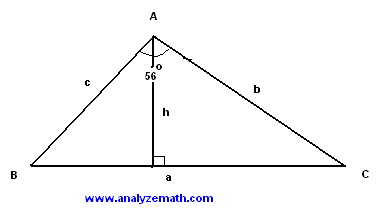Problem 1: Solve a triangle given its perimeter
In the figure below, ABC is a triangle whose perimeter has a length of 100 units and the length of the altitude h is equal to 18 units. The size of the internal angle A is equal to 560 . Find all sides of the triangle.

Solution to Problem 1
- The given perimeter p = 100 gives an equation as follows
a + b + c = p (equation 1)
- The area of the triangle may be calculated using sides c and b as follows
area = (1 / 2) b c sin (A)
- But the area of the triangle may also be calculated using the altitude h and corresponding base a as follows
area = (1 / 2) h a
- We now combine the two expressions for the area to obtain an equation as follows
b c sin (A) = h a (equation 2)
- A third equation is obtained using the law of cosine.
as follows
a 2 = b 2 + c 2 - 2 b c cos (A) (equation 3)
- We now have 3 equations with 3 unknowns which we have to solve. Equation (1) gives
a = p - (b + c)
- Substitute the above into equation (3) to obtain
(p - (b + c)) 2 = b 2 + c 2 - 2 b c cos (A)
- Expand the left hand side of the above equation and simplify
p 2 + (b + c)) 2 - 2 p (b + c) = b 2 + c 2 - 2 b c cos (A)
p 2 + b 2 + c 2 + 2 b c - 2 p (b + c) = b 2 + c 2 - 2 b c cos (A)
p 2 + 2 b c - 2 p (b + c) = - 2 b c cos (A) (equation 4)
- We now use a = p - (b + c) in equation (2) and write
b c sin (A) = h (p - (b + c))
- which may be written as follows
b c sin (A) = h p - h (b + c) (equation 5)
- We now define two variables as follows.
Z = b + c and Y = b c
- and rewrite equations 4 and 5 as follows.
p 2 + 2 Y - 2 p Z = - 2 Y cos (A)
Y sin (A) = h p - h Z
- The above equations make a system of linear equations with unknowns Z and Y.
- 2 p Z + 2 (1 + cos (A)) Y = - p 2
h Z + sin (A) Y = h p
- We now substitute p, h and angle A by their values.
- 200 Z + Y (2 + 2 cos (56)) = - 10000
18 Z + Y sin (56) = 1800
- Solve the above system to obtain
Z = 62.6456 and Y = 811.035
- We now substitute Z by b + c and Y by b c to obtain two equations in b and c as follows.
b + c = 62.6456 and b c = 811.035
- We now combine the above equations to obtain an equation in one unknown as follows.
b + 811.035 / b = 62.6456
- Multiply all terms to obtain a quadratic equation.
b 2 + 811.035 = 62.6456 b
- Solve to obtain.
b = 44.3643 and b = 18.2812
- We now use the equation b c = 811.035 to find c.
for b = 44.3643 , c = 18.2812
and for b = 18.2812, c = 44.3643
- It is in fact one solution since c and b are interchangeable. let the solution be b = 44.3643 units and c = 18.2812 units and find the third side using equation (3)
a 2 = b 2 + c 2 - 2 b c cos (A)
a = sqrt [ 44.3643 2 + 18.2812 2 - 2*44.3643*18.2812 cos (56) ]
a = 37.3543 units - As an example check that the perimeter of the triangle is equal to 100 units.
Problem 2: Find Perimeter of a Right Triangle
Find the perimeter of a right triangle whose sides have sizes of 30 and 40 cm.
Solution to Problem 2

P = x + y + h
We first use the Pythagorean theorem to find the hypotenuse h
x 2 + y 2 = h 2
Substitute x and y by their values
30 2 + 40 2 = h 2
Solve for h
h = √(30 2 + 40 2) = 50 cm
We now calculate the perimeter P of the triangle.
P = x + y + h = 30 + 40 + 50 = 120 cm.
Problem 3: Find Perimeter of an Isosceles Triangle
Find the perimeter of an isosceles triangle whose equal sides have a size of 10 m each and the angle between them equal to 30°.
Solution to Problem 3

x2 = 102 + 102 - 2(10)(10)cos(30°)
Solve for x
x = √(102 + 102 - 2(10)(10)cos(30°)) ≅ 5.18 m
We now calculate the perimeter P of the triangle.
P = x + x + 5.18 = 10 + 10 + 5.18 = 25.18 m.